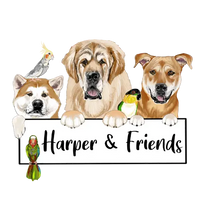The Canine Ancestral Diet: What Does It Mean?
Before discussing the Ancestral Diet for Pets, two things need to be addressed. Epigenetics and Adaptive Evolution.
Epigenetics is the study of how genes are expressed. You may think the genetic code is set in stone. However, certain environmental factors can change how genes express themselves. This means that things like diet or trauma can switch genes on or off. Hundreds of studies have looked at how various diet and environmental stresses influence how genes are expressed. How stresses your parents or even grandparents suffered from long ago could be affecting you today.
The Dutch Hunger Winter provides valuable information about the wide-ranging effects on those born during, after, and even on the children of those born during and after. The Dutch Hunger Winter lasted for six months between 1944 and 1945. Thousands of people starved to death, and millions were vastly undernourished. Among those were pregnant women forced to survive on less than 1000 calories a day.
Scientists have compared those who were in utero with siblings who were not exposed to the stress in the womb.
Researchers have discovered that DNA methylation made changes near genes that control metabolism and cell differentiation during development. It appears the stress of the famine turned off the genes of unborn children, leading them to suffer from an array of health conditions affecting their metabolism. These effects were not just limited to the babies in utero, but has also affected their children.
Adaptive Evolution is the theory that humans and animals evolved and adapted to their environment over time; that advantageous mutations are passed on, and disadvantageous mutilations slowly disappear. This is oftentimes thought of in very simplistic term, but it is far more complex.
Take, for example, a mutation linked to lactate persistence. There is robust evidence of Adaptive Evolution in European and American populations. Why, because pastoral farming for milk started centuries before other parts of the world and has been present in those populations for far longer. By contrast, in areas of the world where it is more recent, a far lower percentage have the mutation and are thus lactose intolerant.
Another example would be an adaptation to high arsenic living conditions in certain populations. A study conducted on a village in Argentina found that they had higher levels of the protective AS3MT allele, and that the alleles had longer stretches of homozygosity. This is generally a sign of positive selection. The higher presence of the AS3MT alleles has allowed for them to survive, despite drinking water that contains over 80 times the safe limit of arsenic established by the World Health Organization.
In today’s global and interconnected marketplace, it is relatively easy to acquire any ingredient. People are no longer limited by what is locally available.
For thousands of years, people were limited to what food was readily available. This is why cuisines are so diverse around the world. What was available in one part of the world wasn’t available in another part of the world. This means humans and the pets they cared for adapted to a diet based on what was locally available.
People often write about the health benefits of following a Mediterranean diet. When you compare that diet to the diets of Inuits in the Arctic Circle, you would be remiss to say that it is a heart attack waiting to happen. Yet that isn’t the case for those Inuits.
In a study looking at 191 Inuits from Greenland, 60 Europeans, and 44 Ethnic Chinese, the research suggested that the Inuit evolved genetic adaptations that allow them to consume a much higher percentage of fat.
The evidence suggested that a group of genes regulated the amount of Omega-3 and Omega-6s that their bodies produce naturally, partly because of the amount that they consume. The evidence also suggested it may have helped in lowering low density lipoprotein (LDL) levels. Only 3% of Europeans and 15% of the Chinese had the same genetic markers.
“What is food for one man may be bitter poison to others -Titus Lucretius Carus”
The quote above is most commonly related to allergies, but it can equally be applied here.
Fewer people today in Greenland eat a traditional diet, and the numbers do show an increase in non-communicable diseases such as diabetes, heart disease, obesity, etc.
Furthermore, there have been several studies showing that when the diets of indigenous populations have changed due to increased integration, there has been a marked increase in many non-communicable diseases.
Now to the point about Dogs.
In today’s society, we feed all dogs a very similar diet. We feed Akitas from the mountainous region of Japan the same basic diet, as a Rhodesian Ridgeback from Southern Africa. We feed a Chihuahua from Mexico the same as a Norwegian Elkhound, and this could go on ad nauseam.
The diets historically would have been very different, based on the foods available in these regions being vastly different not to mention the effect seasons had on what was avaliable. Meaning the diets that they evolved to eat until relatively recently were completely different.
Research does show for example, that there is a wide variation in the number of AMY2B Gene copies among different breeds. AMY2B is responsible for the production of Salivary Amylase, which aids in the digestion of carbs. Breeds that evolved in agrarian societies have more copies than non-agrarian societies. This occurred thousands of years ago. For example, a Husky has fewer copies than an English Springer Spaniel. The reason is that historically, these breeds ate vastly different diets. The Ancestors of today's Huskys would have consumed far fewer carbohydrates as part of their diet than the ancestors of the English Springer Spaniel. See (Arendt 2016, Axelsson 2013)
Furthermore, they would have received different nutrient levels based on what they were consuming. Yet we often feed them the same diet. This is a major flaw in providing what dogs of various ancestral backgrounds require.
It’s well known that the Northern Breeds are more susceptible to zinc deficiency. Dalmatians have problems with uric acid. Several breeds are prone to diabetes. Some breeds are more at risk of developing liver disease from copper buildup in the liver. The list goes on and on. Almost every breed has its own predisposition to a myriad of health conditions.
Some of these conditions could be because we aren’t feeding them a diet that they evolved to eat. We are feeding all dogs the same basic nutritional makeup, when historically, they were likely diverse based on where they evolved.
We already know in humans that when moving aways from the traditional diet of our individual ancestors there is an increase in non-communicable diseases. It only makes sense that the same would apply to our closest companions.
The issues we see today could be the result of increased awareness. It could be a problem of current feeding trends or the feeding trends of previous generations.
The NRC, AAFCO, and FEDIAF Nutrient standards are designed to meet the needs of most dogs. This means an average, but what constitutes the average dog. While the standards probably gets close to meeting the needs of most dogs, it might not be meeting those of specific breeds. That’s not to say that the standards are wrong; it might be that they just need to be tweaked a little for different breeds.
People are often talking about the Paleo diet, but the Paleo Diet ultimately means different things to different areas and people. The same goes for an Ancestral Diet for Cats and Dogs. When discussing the Canine Ancestral Diet, we need to stop thinking about it in terms of percentages. We need to stop applying it to all breeds.
We need to think about where the breed evolved and what the breed ate historically.
Was their diet higher in fat? What was the source of fat? Was it higher in Omega 3s or Omega 6s? Did carbohydrates make up a more significant portion of their diet, because, contrary to what many claim, dogs have been consuming carbohydrates as part of their diet for a significant portion of their history? Did the carbohydrates come from rice, potatoes, grains, legumes or other vegetables? Was their primary protein source fish, poultry, cattle, wild game, or small prey? The answers to these questions is ultimately going to be different based on where they evolved and what the diet of the humans they lived with consumed.
Every ingredient provides a different nutritional profile. Beef Liver and Chicken Liver provide different nutrients in different percentages and ratios. Fish provides far more omega-3 Fatty Acids, while cattle or poultry are higher in Omega 6 fatty acids. Rice provides different nutrients than Corn. We need to look beyond the macronutrients and look at the micronutrient profiles that they ate historically.
For example in humans of different genetic backgrounds, we know that some people are better converters of the plant-based omega 3 ALA to EPA and DHA. At the same time, some genetic backgrounds are poor converters of EPA and DHA. While the studies in dogs shows that they are generally poor converters of ALA to EPA and DHA its likely some are worse than others.
It's possible that these minor differences, while they might not result in a full-blown deficiency, are the reason why more and more breeds are suffering from at least some health conditions.
Side Note
Even if we grant the premise that they ate a similar mixture of Fats, Carbohydrates, and Protein; There would still be a significant difference in the Vitamins, Minerals, fatty acids, and amino acids of the diet. There would also be a difference in the other small molecules that made up their diet. While they might be small it's possible that these small molecules make a profound difference.
Foods are also much more than the macro and micronutrients they provide. Foods also contain many compounds that we don’t traditionally measure. Science is still learning about all of these compounds and the effects they have. Every year there is more and more research exploring Nutrigenomics, and Metabolimics. This research is likely to provide significant insights in the coming years and decades.
Now, there are likely significant differences in the nutritional value of the ancestral foods they ate and the modern equivalent, just as there is a difference between grass-finished and Feed Lot Cattle.
The Canine Ancestral diet is by no means a one-size-fits-all. It varies from breed to breed. This is a shortcoming of the nutrient guidelines developed by AAFCO, NRC, and FEDIAF. We need to recognize that not all breeds are received the same. They evolved on different diets, and their dietary needs are likely different based in part on what nutrients they evolved eating.
There has only really been one attempt to look at The Canine Ancestral Diets with this kind of detailed approach. Canine Nutrition Choosing the Best Food for Your Breed by William D. Cusick. The book was first published in 1990, and a revised edition was published in 1997.
In the book, he makes recommendations for 152 different breeds based on where they evolved and what they likely ate.
Unfortunately, in the time since it was published, the theory hasn’t been pursued, partly because the technology hasn’t been adequate. However, more research is being conducted looking at the genetic differences between breeds, but more than likely there will be personalized nutritional advice for humans based on genetics.
References
Arendt M, Cairns KM, Ballard JW, Savolainen P, Axelsson E. Diet adaptation in dog reflects spread of prehistoric agriculture. Heredity (Edinb). 2016 Nov;117(5):301-306. doi: 10.1038/hdy.2016.48. Epub 2016 Jul 13. PMID: 27406651; PMCID: PMC5061917.
Axelsson, E., Ratnakumar, A., Arendt, ML. et al. The genomic signature of dog domestication reveals adaptation to a starch-rich diet. Nature 495, 360–364 (2013). https://doi.org/10.1038/nature11837


